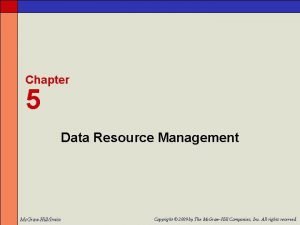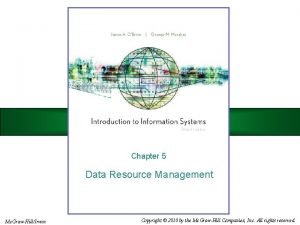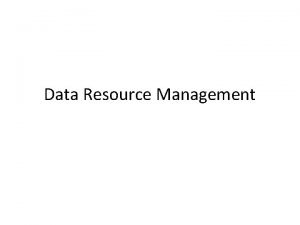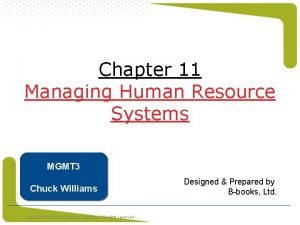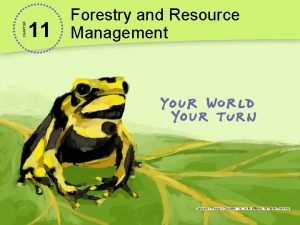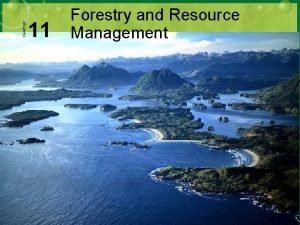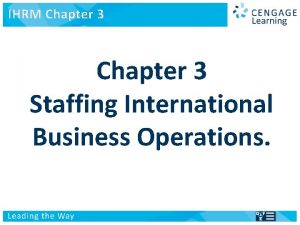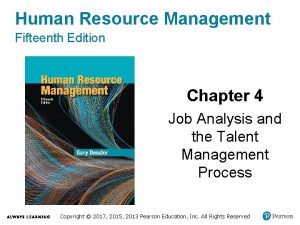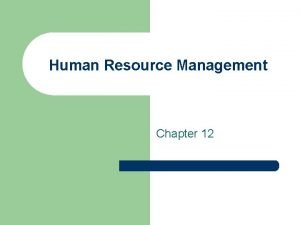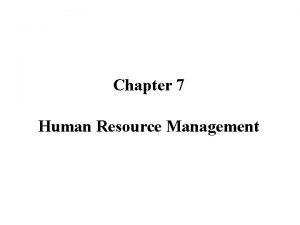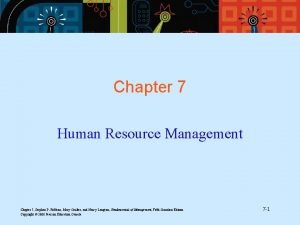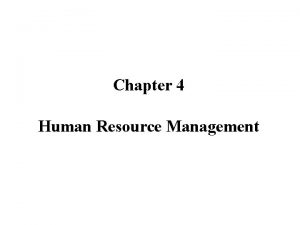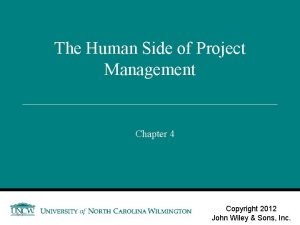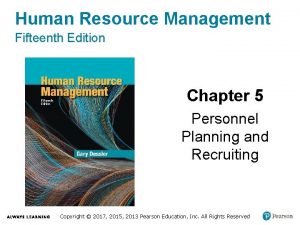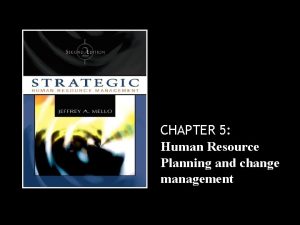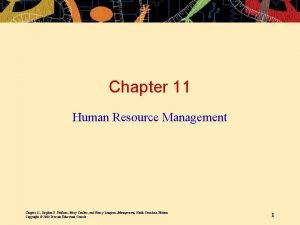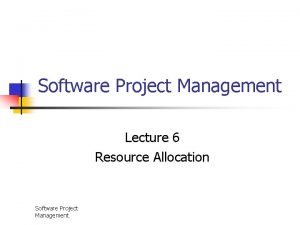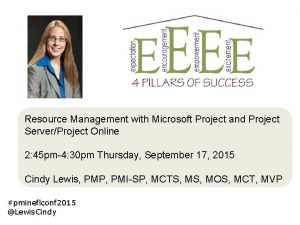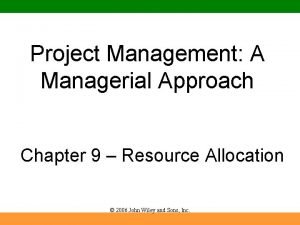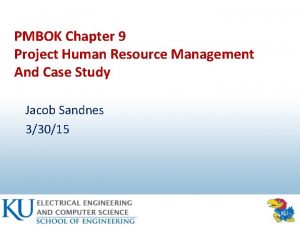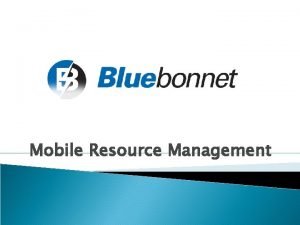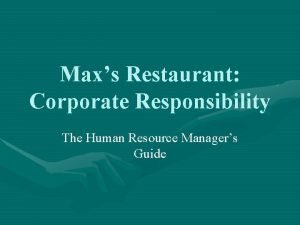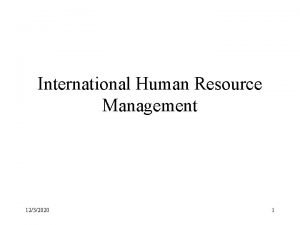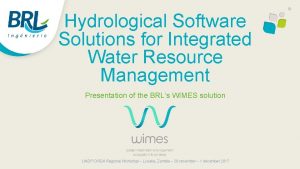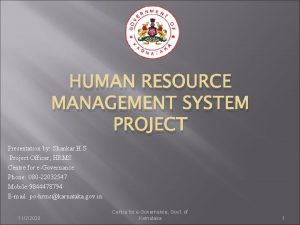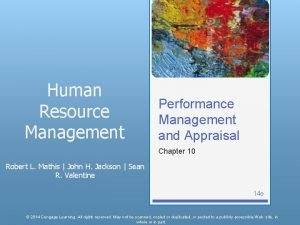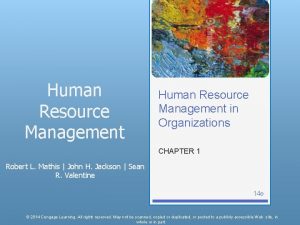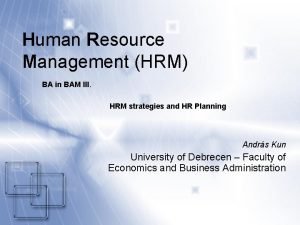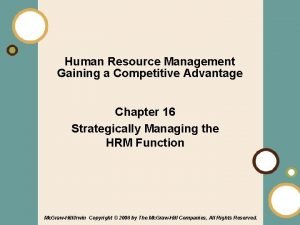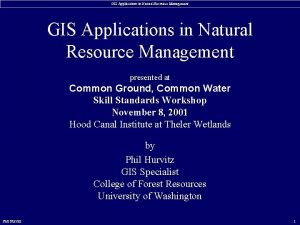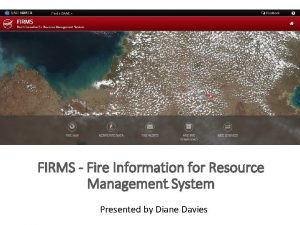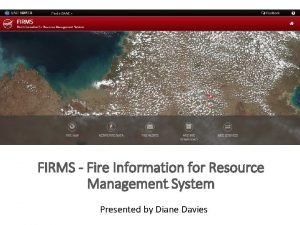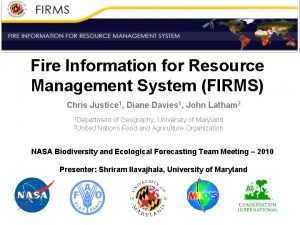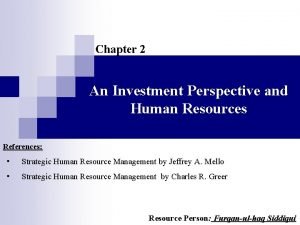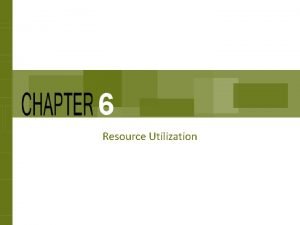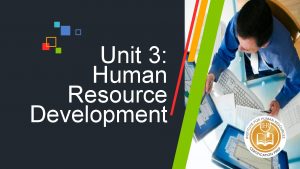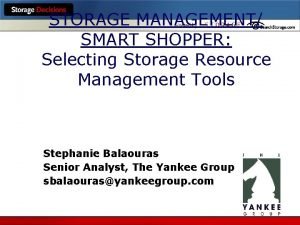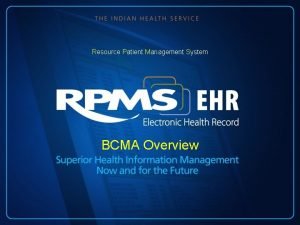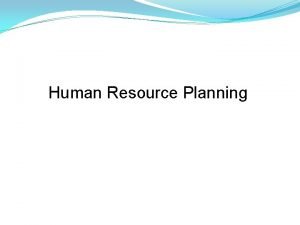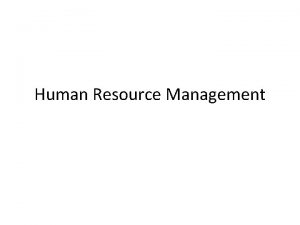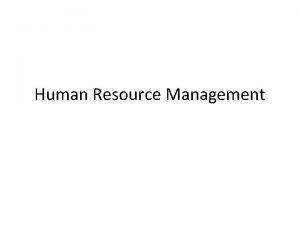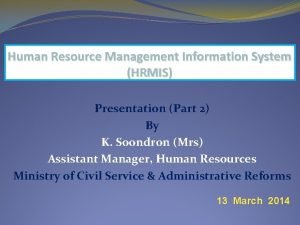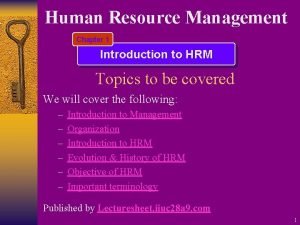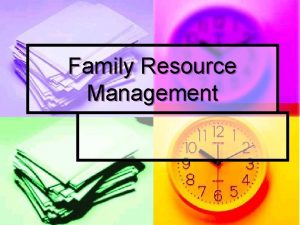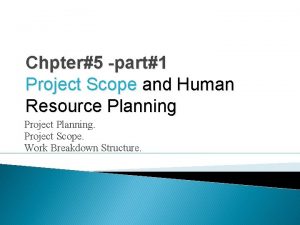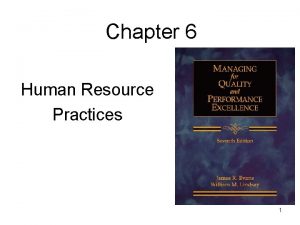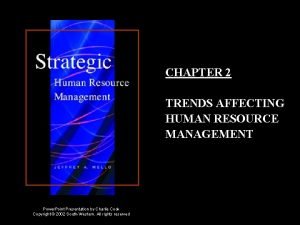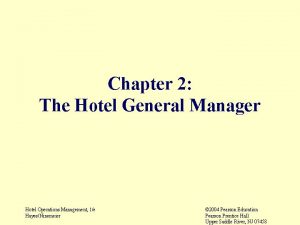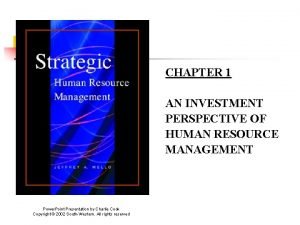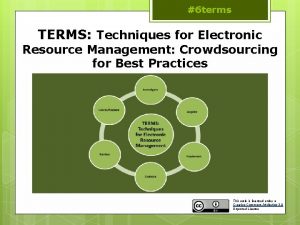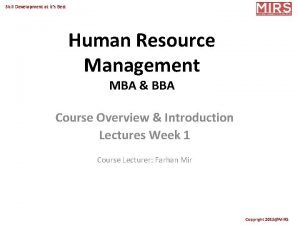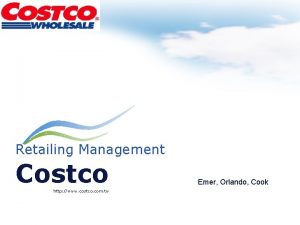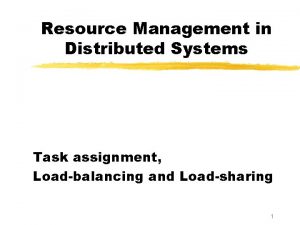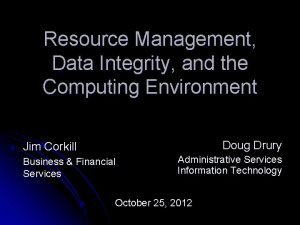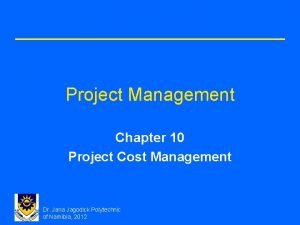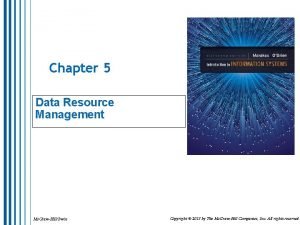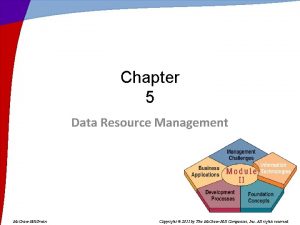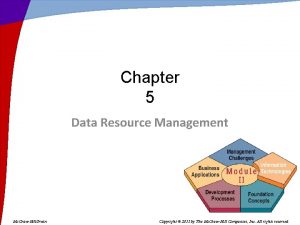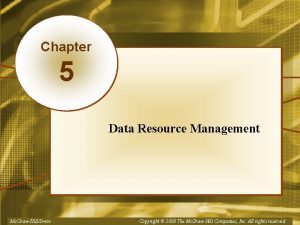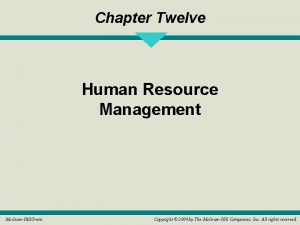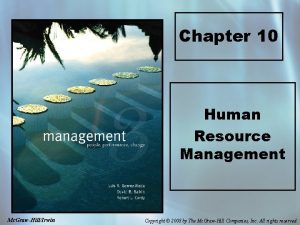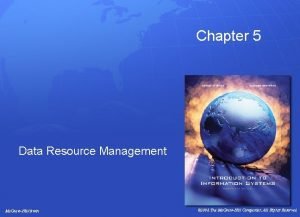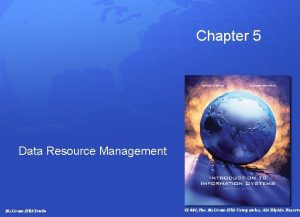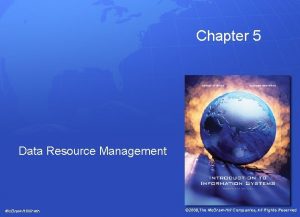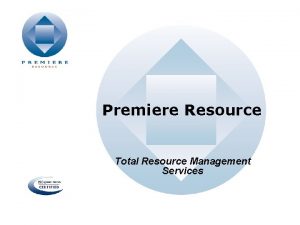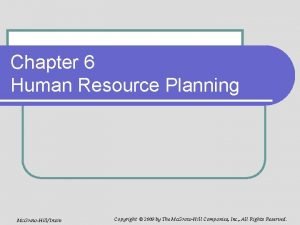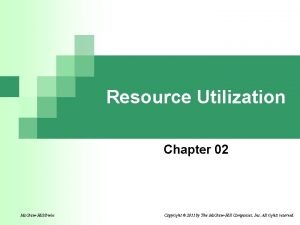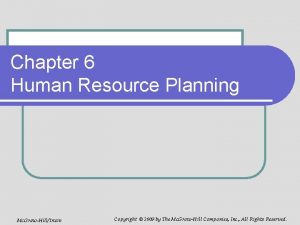Chapter 5 Data Resource Management Mc GrawHillIrwin Copyright




























































































- Slides: 92

Chapter 5 Data Resource Management 授課老師:台大 管系 楊立偉 Mc. Graw-Hill/Irwin Copyright © 2013 by The Mc. Graw-Hill Companies, Inc. All rights reserved.

Learning Objectives v Provide examples to illustrate each of the following concepts: v. Major types of databases 各種不同的資料庫 v. Data warehouses and data mining 資料倉儲及資料探勘 v. Logical data elements 資料庫的組成 v. Fundamental database structures 基本的資料庫結構 v. Database development 資料庫的開發 5 -2

Section 1 Technical Foundations of Database Management 5 -3

I. Database Management System v. Data resources must be structured and organized in some logical manner so they can be accessed, processed, retrieved, and managed easily 5 -4

II. Fundamental Data Concepts v Character (and Number, Date. Time, Boolean) v Field (or Attribute, Property, Column) va grouping of related characters, as a last name or a salary, represents an attribute of some entity v Record (or Row) va grouping of attributes that describe an entity v File (or Table) va group of related data records v Database va collection of logically related data elements 5 -5

II. Fundamental Data Concepts 5 -6

III. Database Structures (Models) v Hierarchical Structure – treelike structure of oneto-many parent-child relationships (each child can have only one parent) v Network Structure – similar to hierarchical but allows many-to-many relationships (a child record can have more than one parent) v Relational Structure – the most widely used database model today; data is represented as a series of two-dimensional tables called Relations; each column is a named attribute of the entity, each row is an unnamed instance of that entity 5 -7

5 -8


III. Database Structures (Models) v Relational Operations v. Select – create a subset that meets a criterion 水平 篩選 v. Project – create a subset of the columns in the temporary tables 垂直篩選 v. Join – temporarily combine two or more tables for comparison 跨表連接 v Multidimensional Structure – variation of the Relational model using multidimensional structures to organize and express relationships 5 -10

III. Database Structures (Models) 使用附表之外鍵 foreign key of dependent table 至主表之主鍵進行�找 primary key of parent table 5 -11

III. Database Structures (Models) (二維)表格 也可以呈現多維資料 5 -12

III. Database Structures (Models) v Object-Oriented Structure 物件導向 vcombining the data of interest and the processes that act on that data into a structure called an object 將資料與允許的操作放在一起 (避免誤用) v. Encapsulation – allows complex data types 封裝 (隱 藏細節) v. Inheritance – allows replication of some/all of the characteristics of a parent object in the creation of a child object 繼承 (讓設計變簡單, 不用一直重覆) 5 -13

III. Database Structures (Models) 5 -14

IV. Database Development v Database Administrator (DBA) – controls development and administration of the database 資料庫管理師 v Data Definition Language (DDL) – used to specify the contents, relationships, and structure of the database 用以定義(設計)資料 庫的語言 5 -15

IV. Database Development v Metadata vdata about the data 例如書目資料 (描述書籍資料) v Data Dictionary vdirectory containing the metadata 例如圖書館的分 類目錄 (涵蓋書本、影片、期刊等的metadata) v Data Planning and Database Design v. Data Modeling (Entity-Relationship Diagrams) – logical models of the data itself; this must be done before choosing the database model v. Schema – the physical/internal view of a system v. Subschema – the logical/external view of a system 5 -16


IV. Database Development Entity Relationship Diagram 5 -18

Sample E-R Diagram 1 0 or 1 1…N 0…N 5 -19

Database Pioneer Rethinks the Best Way to Organize Data v. How do databases currently focus on data to be stored? v. What is suggested as a better away to focus on data warehouses? v. What gains do these changes promise? v. Technology of data capturing, storage, search/retrieve, analysis and applications 5 -20

Hadoop: Ready for the Large-scale Databases of the Future v What is the strength of Hadoop? v distributed and scalable v What does Hadoop do differently from pervious databases? v HDFS : Hadoop distributed filesystem v Map. Reduce : in a "divide-and-conquer“ way v Why do we need something different today for handling data in databases? v Big data : volume, velocity, variety v What does this tell you about the future of handling data? 5 -21

Section 2 Managing Data Resources 5 -22

I. Data Resource Management v. Data are an organizational resource that must be managed as any other resource 5 -23

I. Data Resource Management Types of Databases Used by Organizations and End-Users 5 -24

II. Types of Databases v Operational Databases – store detailed data to support business processes and operations vc. f. Informatonal Databases (Data warehouse) v Distributed Databases – many organizations distribute their databases over multiple locations v External Databases – outside the firm, free or fee-based v Hypermedia Databases – hyperlinked pages of multimedia 5 -25

Coty: Using Real-Time Analytics to Track Demand v. What percentage of retails products are usually out of stock in the U. S. ? v. What percentage of promotional items are usually out of stock in the U. S. ? v. What effect does this have on business? v. How does Coty deal with these issues? 5 -26

III. Data Warehouses and Data Mining v. Data Warehouse – stores data extracted from other databases v. Data Mart – subset of a data warehouse focusing on a single topic, customer, product, etc. v. Data Mining – analyzing a data warehouse to reveal hidden patterns and trends 5 -27

n Data Warehouse: n n n A subject-oriented, integrated, time-variant, nonupdatable collection of data used in support of management decision-making processes Subject-oriented: e. g. customers, patients, students, products Integrated: Consistent naming conventions, formats, encoding structures; from multiple data sources Time-variant: Can study trends and changes Non-updatable: Read-only, periodically refreshed Data Mart: n A data warehouse that is limited in scope Ex. Corporate (Data Warehouse) v. s. Department (Data Mart) Chapter 11 n 28

III. Data Warehouses and Data Mining Components of a Data Warehouse System 5 -29

III. Data Warehouses and Data Mining A Data Warehouse and its Data Mart Subsets 5 -30

III. Data Warehouses and Data Mining Extracts Business Knowledge from a Data Warehouse 5 -31

IV. Traditional File Processing v Data was stored in independent files without regard to other needs for that data v Problems of File Processing – databases seek to solve these problems v 1. Data Redundancy – the same data is kept in more than one location; databases seek to Control (NOT reduce!) Redundancy; this led to Data Inconsistency – same data in multiple locations but the Values were Different 5 -32

IV. Traditional File Processing (Cont. ) v 2. Lack of data Integration – data not easily available for ad hoc requests v 3. Data Dependence – data and programs were “tightly coupled”, changing one meant having to change the other v 4. Lack of Data Integrity (Standardization) – data was defined differently by different end users or applications 5 -33

V. Database Management Approach v Consolidate the data from separate files into databases accessible by multiple application programs v. Database Management System (DBMS) – a collection of programs to create, maintain, and use (retrieve) data in a database v. Database Maintenance – organizational databases need to be updated continually v. Application Development – facilitated by the Data Manipulation Language (DML) provided by the DBMS 5 -34

V. Database Management Approach v Database Interrogation – query (“ask”) the database for information v Query Language – allows ad hoc requests of the database v SQL Queries (Structured Query Language) – standard query language found in many databases v Boolean Logic – 3 logical operators: AND, OR, and NOT v Graphical and Natural Queries – easier methods of structuring SQL statements 5 -35

Online Dating: The Technology Behind Finding Love v. Are all dating sites the same? For users, what makes the difference between different dating sites? v. What is the biggest challenge for e. Harmony? v. When is the demand for e. Harmony’s services greatest? Why might this be? What does this mean from a business perspective? 5 -36



• Amazon's Recommendation – data mining • to guess what you would like based on past records – collaborative filtering • "customers who viewed this also viewed…"

案例 : Target http: //www. forbes. com/sites/kashmirhill/2012/02/16/how-target-figured-out-a-teen-girl-was-pregnant-before-her-father-did/

Big Data 的應用方式 運用資料與演算,達成智慧決策 需要快速、大量、各式資料的處理分析能力 Information & Insights Data • Structured • Unstructured • Historic • • Modeling 模型 Deduction 演繹 Inference 推理 Prediction 預測 Decisions & Actions • • Results 結果 Options 選項 Prevention 預防 Suggestion 建議 "turning data into action" 41


Chapter 6 Telecommunications and Networks 授課老師:台大 管系 楊立偉 Mc. Graw-Hill/Irwin Copyright © 2013 by The Mc. Graw-Hill Companies, Inc. All rights reserved.

Section 1 Telecommunications and Networks 6 -44

I. Networking the Organization v. Merging computing and communications yields computer networks which are more than the sum of their parts. 6 -45

II. The Concept of a Network v. The Concept of a Network – an interconnected/interrelated system v. Metcalf’s Law – the utility (use) of a network equals the square of the number of users v網路價值以用戶數量的平方的速度增長 va. k. a Network effect 網路效應, Network Externality 網路外部性 v外部性效果:使用者愈多對原來的使用者而言, 不僅其效果不會如一般經濟財(人愈多分享愈 少),反而其效用會愈大 6 -46

III. Trends in Telecommunications 6 -47

III. Trends in Telecommunications v Telecommunications – the exchange of information in any form over a network v. Industry Trends – massively changed from government regulated monopolies to a fiercely competitive markets with many choices v. Business Application Trends – all these changes have caused significant changes in the businesses use of telecommunications v. Internet 2 – a high performance network using an entirely different infrastructure from the public Internet; used mostly by universities (educational), research, and government 6 -48

III. Trends in Telecommunications v Technology Trends v Internet Networking Technologies – open systems with unrestricted connectivity using Internet networking technologies v Open Systems – IS using common standards for h/w, s/w, applications, and networking v Middleware – programs that mediate between other programs; an essential part of IT infrastructure because it joins disparate systems v Wireless technologies 6 -49

IV. The Business Value of Telecommunications Networks v Cut costs, shorten lead/response times, improve collaboration, support e-commerce v. The Internet Revolution – a “network of networks”, the largest and most important network, constantly expanding v. Internet Service Providers (ISP) – provides easy access to the Internet v. Internet Applications – browsing the Net, email, instant messaging v. Business Use of the Internet – the Internet adds value to every prt of the business cycle v. The Business Value of the Internet 6 -50

6 -51

6 -52

Telepresence: GE Does Training and Meetings Face to Face , but Virtually v What is the ultimate competitive advantage? v What did GE want to reduce/eliminate from meetings and training? v How did participants respond to the meetings? v How would you feel about this type of meeting? This type of training? 6 -53

V. The Role of Intranets v Intranet – a private internal network using Internet technologies v The Business Value of Intranets – an enterprise information portal supporting communications and collaboration v Communications and Collaboration – improved by Intranets v Web Publishing – developing and publishing hyperlinked multimedia documents v Business Operations and Management – develop/deploy critical applications supporting operations and managerial decision making v Intranet Portal Management – managed by IS/IT professionals 6 -54

6 -55

Intranet dashboard Revs Up Audi Australia v What was Audi’s problem? v Why was the old portal a problem? v What did they want to do with the portal? v What solution did i. D provide? 6 -56

VI. The Role of Extranets v Extranet – A private network using Internet technologies (intranet) opened to select external entities for purposes of communications v Purpose – interconnect the business with its suppliers/customers/business partners 6 -57

VI. The Role of Extranets connect the internetworked enterprise to customers, suppliers, and trading partners 6 -58

The NFL Scores with New Extranet v According to the case, in 1997 the NFL was the first major sport league to do what? v By 2008, what had happened? What had happened in that time? v What solution did the NFL provide? v How does this help the NFL from a business standpoint? 6 -59

Section 2 Telecommunications Network Alternatives 6 -60

I. Telecommunications Alternatives v. Telecommunications is a highly technical, rapidly changing field, but most business professional do not need detailed knowledge of these details 6 -61

II. Telecommunications Network Model – 5 basic components: v. Terminals – any input/output device to transmit/receive data v. Telecommunications Processors – support data transmission/reception between terminals v. Telecommunications Channels – media over which messages are sent v. Computers – interconnected by telecommunications networks v. Telecommunications control software – programs to control telecommunications activities and functions 6 -62

6 -63

III. Types of Telecommunications Networks v A Network is defined by its geographic area and who owns the equipment v. Wide Area Networks (WAN) – between cities/large geographic areas, LANs connected by common carrier or leased lines v. Metropolitan Area Networks (MAN) – LANs connected over a specific geographical area v. Local Area Networks (LAN) – equipment owned by the firm, short distances, usually within a single building (or room) 6 -64

III. Types of Telecommunications Networks A LAN allows sharing of resources 6 -65

6 -66

III. Types of Telecommunications Networks v. Virtual Private Networks (VPN) – a network using the Internet as a backbone but incorporating security for privacy v. Client/Server Networks – a powerful, central computer (server) providing information and processing (services) to multiple end-user computers (clients) v. Network Computing – a minimally-powered browser-based computer obtains its data and processing from the Internet 6 -67

Wireless VPNs: Alternatives for Secure Remote Access v. What is VPN? v. Why is a VPN important to business travelers today? v. What is the challenge of a VPN today? 6 -68

6 -69

6 -70

6 -71

III. Types of Telecommunications Networks v. Peer-to-Peer Networks (P 2 P) v. Central Server Architecture – P 2 P software connects a PC to the central server with a directory of all other users (peers) v. Pure Peer-to-Peer – PCs connected without any central server v. Every peer communicates with its neighbors, and then propagate to the network. 6 -72

IV. Digital and Analog Signals v. Analog (continuous) – any value between the maximum/minimum value is possible (e. g. , any frequency between 20 hz and 20 K hz) v. Digital (discrete) – only certain values are permitted (e. g. , 0 and 1) 6 -73

V. Telecommunications Media – the physical pathway over which signals travel v. Twisted-Pair Wire – pair of very thin copper wires twisted in opposite directions (noise reduction); cheap, easy to use, but low bandwidth 雙絞線 v. Coaxial Cable – central copper wire wrapped with insulator, an external wire braid surrounded by a cover; not as easy to manipulate, more expensive than twisted pair, but higher bandwidth 銅軸電纜 6 -74

V. Telecommunications Media v Fiber Optics – hair-thin glass fibers wrapped in protective jacket (cladding), conducts light (photons); difficult to handle, expensive, but highest bandwidth 光纖 v The Problem of “The Last Mile” 最後一哩 – although a telecomm provider puts the latest technology to your door, your home/office is still wired with old fashioned technology, so all the provider’s efforts do not help once the signal reaches your location and you are constrained (limited) by the technology in your own home/office 6 -75

6 -76

6 -77

VI. Wireless Technologies – communications without wires v Terrestrial Microwave – earth-bound towers and line-of-sight radio signals, towers placed on hills and tops of building v Communications Satellites – also use microwaves, satellites in geosynchronous orbits, for voice, video, and data v Cellular and PCS Systems – use cellular technologies v Wireless LANs – cheaper than re-wiring a building v Bluetooth – short range wireless v The Wireless Web – wireless is becoming so popular that new wireless standards for the Web are appearing 6 -78

View from Space: Satellite Farming for Greener Pastures v. How are farmers using technology to better manage their farms? v. How has NASA helped farmers manage their pastures? v. How does technology enable farmers to better control their costs and outputs? 6 -79

Around the World: Mobile Buying and Banking v. How much did mobile shopping increase in 2009? What did mobile phone users do to make this happen? v. What was the increase in mobile banking in 2009? v. What is a point-to-point payment system? Why is it important? 6 -80

VII. Telecommunications Processors – perform a variety of support functions in networks v. Modems – Modulate/Demodulate – change digital signals to analog and analog to digital to use common carrier (voice lines) between computers; most common processor v. Inter-Network Processors – connects networks; switches, routers, hubs v. Multiplexor – allows a single channel to carry multiple signals at one time 6 -81

VIII. Telecommunications Software v Network Management – network operating systems and telecommunications monitors 6 -82

IX. Network Topologies v Topologies – the structure (or “look”) of a network; 3 basic types: bus, ring, star v Protocols – formal rules for communications v Network Architectures v The Internet’s TCP/IP – Transmission Control Protocol/Internet Protocol – the standard protocol for the Internet v Voice Over IP – Internet telephony, replaces publicswitched service 6 -83

IX. Network Topologies 6 -84

IX. Network Topologies v The OSI Model – a standard “reference model” for how messages should be transmitted v. Layer 1: v. Layer 2: v. Layer 3: v. Layer 4: v. Layer 5: v. Layer 6: v. Layer 7: The physical layer The data link layer The network layer The transport layer The session layer The presentation layer The application layer 6 -85

6 -86

Ottawa Regional Hospital: Lowering Costs While Converting to Vo. IP v. What was the problem with the old phone system? v. What does the new phone system do for the hospital complex? v. Why is this appropriate for a modern medical complex? 6 -87

X. Bandwidth Alternatives v. Bandwidth: the capacity of a network 6 -88

6 -89

XI. Switching Alternatives v. Switching Alternatives – packet switching and other new ideas to replace the standard circuit switching of POTS (Plain Old Telephone Service) 6 -90

XII. Network Interoperability v. Network Interoperability – common procedures and protocols so that anyone on a network can communicate with anyone else on another network 6 -91

6 -92
 Resource leveling is the approach to even out the peaks of
Resource leveling is the approach to even out the peaks of Contoh resource loading
Contoh resource loading Data resource management
Data resource management Data resource management
Data resource management Data resource adalah
Data resource adalah Time management human resources
Time management human resources Retail organization structure
Retail organization structure Human resources defintion
Human resources defintion Human resource management chapter 2
Human resource management chapter 2 Chapter 9 human resources management
Chapter 9 human resources management Chapter 11 human resource management
Chapter 11 human resource management Chapter 11 forestry and resource management
Chapter 11 forestry and resource management Battling over clayoquot big trees worksheet answers
Battling over clayoquot big trees worksheet answers Human resource management chapter 1
Human resource management chapter 1 Human resource management lecture chapter 1
Human resource management lecture chapter 1 Management fifteenth edition
Management fifteenth edition Human resource management lecture chapter 1
Human resource management lecture chapter 1 Determinants of staffing choices
Determinants of staffing choices Human resource management chapter 4
Human resource management chapter 4 Function of hrm
Function of hrm Chapter 7 human resource management
Chapter 7 human resource management Chapter 7 human resource management
Chapter 7 human resource management Human resource management chapter 4
Human resource management chapter 4 Human side of project management
Human side of project management Human resource management chapter 5
Human resource management chapter 5 Human resource management chapter 5
Human resource management chapter 5 Chapter 11 human resource management
Chapter 11 human resource management Tivoli storage resource manager
Tivoli storage resource manager Resource requirements example
Resource requirements example Microsoft project server resource management
Microsoft project server resource management Resource leveling
Resource leveling Project human resource management pmbok ppt
Project human resource management pmbok ppt Project human resource management pmbok
Project human resource management pmbok Mobile resource management solutions
Mobile resource management solutions Resource management importance
Resource management importance Recruitment process of max's restaurant
Recruitment process of max's restaurant Meaning of hrm
Meaning of hrm Human induction meaning
Human induction meaning Water resource management software
Water resource management software Hrms.shanker group
Hrms.shanker group Mbo performance appraisal method
Mbo performance appraisal method Current issues in human resource management
Current issues in human resource management Ba human resource management
Ba human resource management Identify job vacancy
Identify job vacancy Human resource management gaining a competitive advantage
Human resource management gaining a competitive advantage Downsizing
Downsizing Human resource management gaining a competitive advantage
Human resource management gaining a competitive advantage Human resource management question paper 2020
Human resource management question paper 2020 Management fifteenth edition
Management fifteenth edition Line and staff aspects of hrm
Line and staff aspects of hrm Strategic human resource
Strategic human resource Application of gis in natural resource management
Application of gis in natural resource management Fire information for resource management system
Fire information for resource management system Nasa firms fire
Nasa firms fire Fire information for resource management system
Fire information for resource management system The importance of water resources
The importance of water resources Investment perspective of hr
Investment perspective of hr Information technology resource management
Information technology resource management What are the objectives of bridge resource management
What are the objectives of bridge resource management Applied psychology in human resource management
Applied psychology in human resource management A c f h k
A c f h k Intro to human resource management
Intro to human resource management Unit 3 human resource management
Unit 3 human resource management Automated storage resource management
Automated storage resource management Separation in human resource management
Separation in human resource management Resource patient management system
Resource patient management system Oracle project resource management
Oracle project resource management Human resources and job design
Human resources and job design Weiterbildung human resources management
Weiterbildung human resources management Resource management responsibilities
Resource management responsibilities Human resource management syllabus harvard
Human resource management syllabus harvard 5p model of hrm
5p model of hrm Hrmis my way
Hrmis my way Definition of human resources
Definition of human resources Introduction to hrm
Introduction to hrm Human resource management laura portolese
Human resource management laura portolese Family resource management definition
Family resource management definition Wbs human resource management
Wbs human resource management Human resource management of toyota
Human resource management of toyota International human resource management dowling 6th edition
International human resource management dowling 6th edition Factors affecting human resource management
Factors affecting human resource management Resource management responsibilities
Resource management responsibilities Investment perspective of human resource management
Investment perspective of human resource management The role of psychology in human resources management
The role of psychology in human resources management Applied psychology in human resource management
Applied psychology in human resource management Techniques for electronic resource management
Techniques for electronic resource management Define human resource management and payroll cycle
Define human resource management and payroll cycle Define retrenchment in human resource management
Define retrenchment in human resource management Hrm practices
Hrm practices Costco.com tw
Costco.com tw Resource management in distributed system
Resource management in distributed system Integrity resource management
Integrity resource management Resource and cost planning
Resource and cost planning


